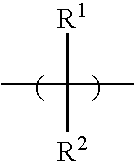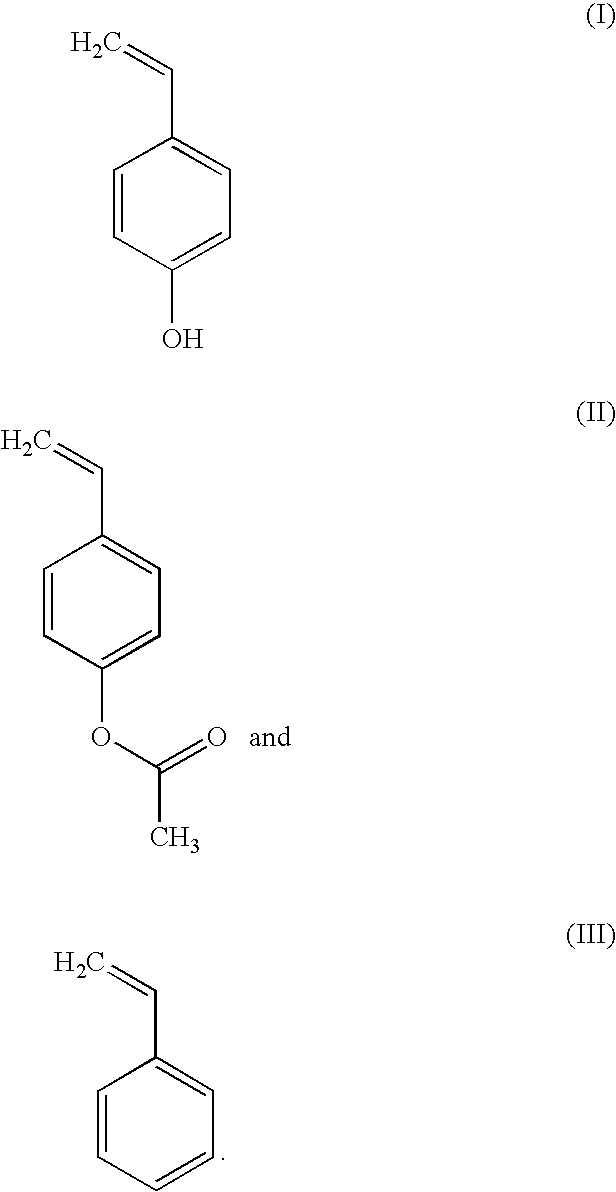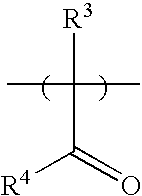Developable bottom antireflective coating compositions especially suitable for ion implant applications
a technology of anti-reflective coating and developer, which is applied in the field of microelectronics, can solve the problems of high reflectivity from the substrate, undetectable high critical dimension (cd) variation of the wafer, and limit the resolution of the resist image, etc., and achieve good reflectivity control, good adhesion to the substrate, and good dissolution properties in the developer
- Summary
- Abstract
- Description
- Claims
- Application Information
AI Technical Summary
Benefits of technology
Problems solved by technology
Method used
Image
Examples
example 1
Synthesis of terpolymers of 4-hydroxystyrene, 1-ethylcyclopentyl methacrylate, and 3-hydroxy-1-adamantyl methacrylate (HS / ECpMA / HAdMA(30 / 20 / 50)) (WS-10)
[0060]To a round bottom flask equipped with condenser, thermometer, an argon (Ar) inlet, and a magnetic stirrer bar, the following were added: 4-acetoxystyrene monomer (2.43 grams (g), 0.015 mole), 1-ethylcyclopentyl methacrylate monomer (1.82 g, 0.01 mole), 3-hydroxy-1-adamantyl methacrylate monomer (5.91 g, 0.025 mole), 2,2′-azobis(2-methylpropionitrile) (AIBN)(0.41 g, 5% of total moles of monomers), and approximately 40 g of tetrahydrofuran (THF). The reaction mixture was stirred at room temperature and bubbled with Ar flow for 45 minutes before it was heated. The reaction was carried out overnight at 72° C. under an inert Ar atmosphere. The reaction solution was then cooled to room temperature and approximately 20 g of THF was blown away by a high flow of nitrogen bubbling into the flask. To the remaining reaction solution, 18 g ...
example 2
Synthesis of terpolymers of 4-hydroxystyrene, t-butyl acrylate, and 3-hydroxy-1-adamantyl methacrylate (HS / TBA / HAdMA(30 / 25 / 45)) (WS-17)
[0061]To a round bottom flask equipped with condenser, thermometer, an argon (Ar) inlet, and a magnetic stirrer bar, the following were added: 4-acetoxystyrene monomer (2.43 grams (g), 0.015 mole), t-butyl acrylate monomer (1.6 g, 0.0125 mole), 3-hydroxy-1-adamantyl methacrylate monomer (5.319 g, 0.0225 mole), 2,2′-azobis(2-methylpropionitrile) (AIBN)(0.328 g, 4% of total moles of monomers), and approximately 40 g of tetrahydrofuran (THF). The reaction mixture was stirred at room temperature and bubbled with Ar flow for 45 minutes before it was heated. The reaction was carried out overnight at 72° C. under an inert Ar atmosphere. The rest of the synthetic procedures are the same as Example 1, except approximately 5 g of concentrated NH4OH was used in deprotecting the acetoxy groups from acetoxystyrene repeat units to form hydroxyl styrene repeat unit...
example 3
Patterning of HS / ECpMA / HAdMA(30 / 20 / 50) Polymer
[0062]Formulation was prepared by dissolving 100 mg of polymer prepared in EXAMPLE 1 and 5 mg of TPS PFBuS in 4-methyl-2-pentanol. It was then filtered through 0.2 μm PTFE filter and spincoated onto a clean silicon wafer at about 1500 RPM. The wafer was then baked at 180° C. for 60 sec. Subsequently the wafer was coated with a ArF photoresist and imaged using binary mask in a ArF stepper. The wafer was baked at 100° C. and developed in a standard 0.26N developer. The X-SEM of printed pattern for 135 nm lines / spaces showed improved sidewall profile compared to images created without use of the DBARC of the invention.
PUM
 Login to View More
Login to View More Abstract
Description
Claims
Application Information
 Login to View More
Login to View More - R&D
- Intellectual Property
- Life Sciences
- Materials
- Tech Scout
- Unparalleled Data Quality
- Higher Quality Content
- 60% Fewer Hallucinations
Browse by: Latest US Patents, China's latest patents, Technical Efficacy Thesaurus, Application Domain, Technology Topic, Popular Technical Reports.
© 2025 PatSnap. All rights reserved.Legal|Privacy policy|Modern Slavery Act Transparency Statement|Sitemap|About US| Contact US: help@patsnap.com



